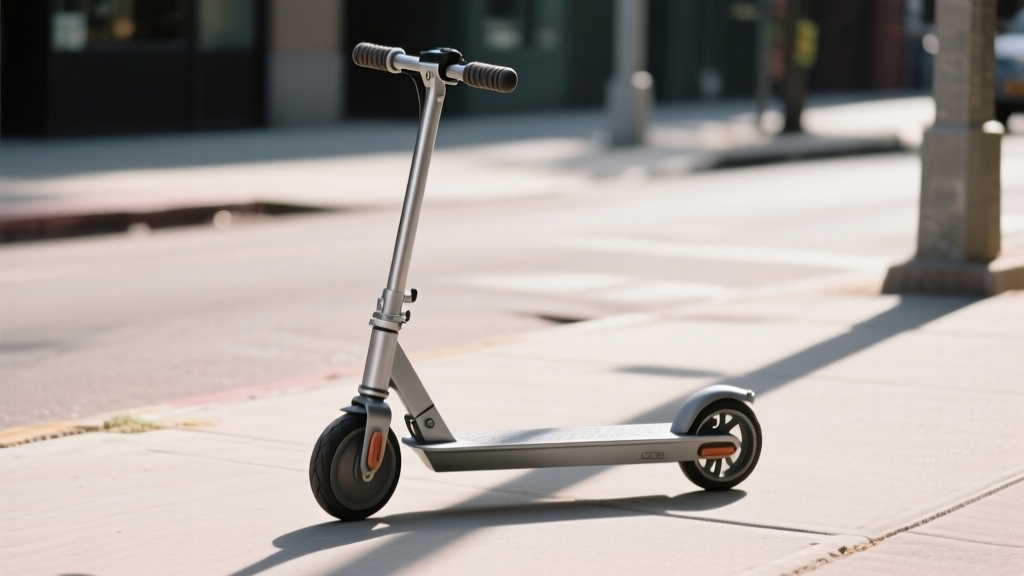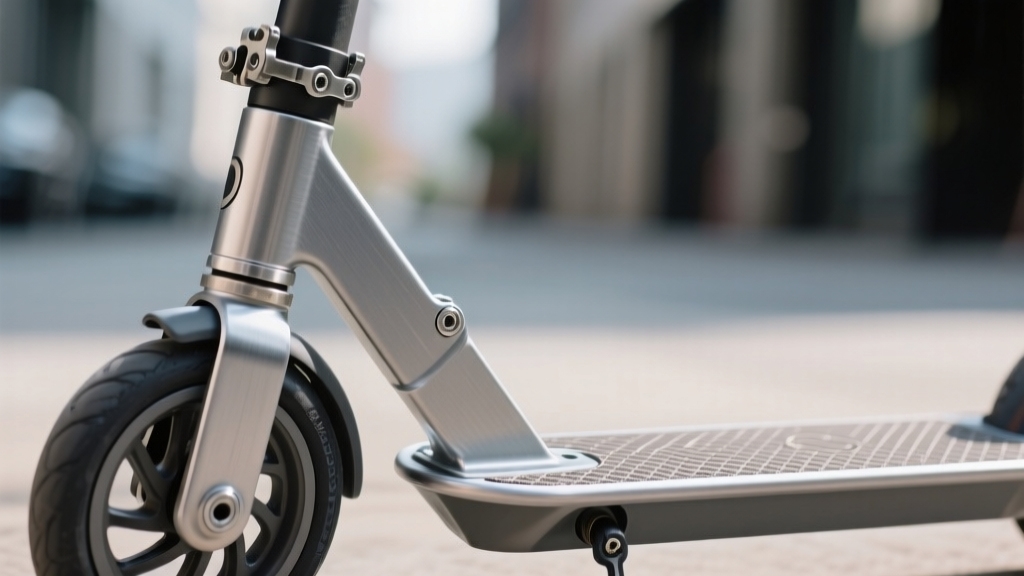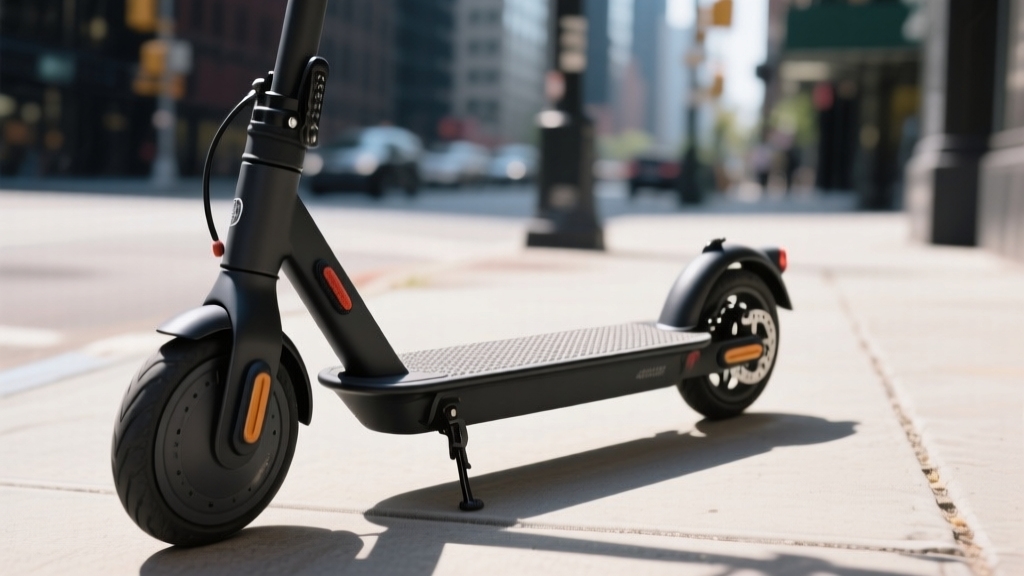You use a kick scooter by pushing off the ground with your foot on a lightweight two-wheeled platform equipped with handlebars for steering. Made mainly from aluminum or composite materials, kick scooters combine portability with practical urban mobility.
They originated from early 19th-century designs and have evolved into efficient tools for short-distance travel and recreation. Their growing popularity reflects shifting urban lifestyles and innovations that continue to enhance performance and convenience. Exploring their history and features reveals even more about their impact.
Key Takeaways
- A kick scooter is a human-powered vehicle propelled by pushing off the ground with one foot while standing on a deck.
- It typically features a handlebar, a narrow deck, and two wheels, often made from lightweight materials like aluminum or carbon fiber.
- Many models include folding mechanisms for easy portability and compact storage.
- Wheels are usually polyurethane, ranging from 100mm to 200mm, designed for durability and smooth riding.
- Kick scooters are used for urban commuting, recreation, and first/last-mile travel, offering an eco-friendly, convenient mobility option.
Definition and Basic Features of a Kick Scooter

Although you might see various types of scooters on the streets, a kick scooter stands out as a simple, human-powered vehicle propelled by pushing off the ground with your leg. You’ll recognize it by its handlebar, deck, and two wheels, designed primarily for urban commuting, short trips, or recreation.
Made from lightweight materials like aluminum or steel, it’s easy to carry and maneuver. Many models also feature folding mechanisms for compact storage. Unlike electric scooters, it doesn’t rely on motors or batteries; all movement depends on your effort. Most electric scooters, by contrast, are propelled by an electric motor, eliminating the need for gears and sometimes featuring regenerative braking.
Constructed from lightweight metals, kick scooters require no batteries, relying solely on your own power to move.
Wheels typically range from 100mm to 200mm, crafted with polyurethane for durability and grip. Many models fold for compact storage. Braking options vary, from foot brakes to hand brakes, while some even have suspension for comfort.
Historical Development and Early Models
You’ll find that the kick scooter’s roots stretch back to early 19th-century inventions like the Laufmaschine, which set the stage for later designs.
By the early 20th century, simple scooters made from wood and metal became popular in urban areas, especially as affordable toys for children.
These early models varied in construction but shared basic features that made them easy to use and fun to ride. Many of these early scooters were handmade in Europe and the US since the 1920s, primarily as children’s toys.
Origins and Inventions
The origins of the kick scooter trace back over two centuries to 1817, when Karl von Drais invented the first two-wheeled vehicle. This invention set the foundation for future developments in personal transportation.
By the late 19th century, homemade scooters with wooden boards and roller skate wheels became popular children’s toys in Europe and the U.S. These early models were simple but effective, sparking widespread interest. Folding mechanisms were not yet introduced, so these scooters remained rigid and less portable.
These early designs paved the way for commercial manufacturing, which retained wooden frames and similar wheel designs. Innovations like the leaning mechanism were introduced to help riders steer more easily. Around the same time, inventors like Elmer R. Johnson contributed to early electric scooter development, laying the groundwork for future designs with electric motors.
Motorized scooters, such as the 1916 Autoped, influenced the scooter landscape but differed significantly from kick scooters. They served a different market with powered propulsion.
A major turning point came in 1990 when Wim Ouboter invented the modern portable scooter. His design combined portability with improved materials, leading to the scooters we recognize today. The introduction of folding technology greatly enhanced scooter convenience and storage.
| Year | Milestone |
|---|---|
| 1817 | Karl von Drais invents two-wheeler |
| Late 1800s | Homemade wooden scooters emerge |
| 1916 | Autoped motorized scooter patent |
| 1990 | Ouboter invents modern kick scooter |
Early Urban Usage
Since the 1920s, urban areas in Europe and the United States saw handmade kick scooters become common among children and youth.
These early models were crafted primarily from wood, with roller skate wheels and steel ball bearings to enhance durability and rolling ease.
As you explore their usage, note how these scooters combined play and practical mobility. They were constructed from wooden boards with repurposed handles and wheels, often 3 to 4 inches in diameter.
Steering was achieved by leaning or a linked pivot mechanism between two boards. They served as affordable personal transport and recreation during economic hardships like the Great Depression. These scooters featured in urban settings such as Paris and Berlin for racing and leisure activities.
Early push scooters were basic but provided hours of fun and exploration, evolving from homemade wooden toys with attached roller skate wheels and stick handles, highlighting their simple start.
Their development paralleled the rise of other human-powered vehicles, illustrating the broader cultural significance of personal mobility devices in urban life.
Materials and Construction Techniques

Although kick scooters may look simple, their materials and construction techniques involve careful choices to balance strength, weight, and durability.
Kick scooters combine thoughtful materials and design to achieve optimal strength, weight, and durability.
You’ll find 6061 aluminum alloy commonly used for frames and rails because it offers a high strength-to-weight ratio and corrosion resistance.
Carbon fiber layers often reinforce decks for added stiffness while keeping weight low. Construction blends cutting, milling, and CNC machining to shape and drill precise components.
Assembly relies on socket-head screws and slot-and-insert systems for modularity and aerodynamic integrity. Suspension parts frequently use custom aluminum bar stock, integrating shock absorbers from mountain bikes.
Deck supports combine aluminum rails with composite or acrylic decks, reinforced by metal plates. Wheels mount on custom axles with threaded rods and secure fasteners, ensuring durability under load and smooth performance.
For added stability during transport or maintenance, some riders use motorcycle wheel chocks adapted to secure scooters safely.
Types and Variations of Kick Scooters
Understanding the materials and construction behind kick scooters sets the stage for exploring their diverse types and variations.
You’ll find scooters designed for specific uses, from commuting to sport. Consider wheel size, frame strength, and intended terrain when choosing one. The variety of scooter types allows selection based on terrain, purpose, and rider skill. Proper maintenance and regular inspection help ensure safety and durability.
Here are key types you might encounter:
- Traditional Kick Scooters: Lightweight, ideal for short urban trips.
- Stunt Scooters: Reinforced for tricks and park use.
- Off-Road Scooters: Equipped with rugged tires for rough terrain.
- Electric Kick Scooters: Combine manual kicking with motorized assistance.
Each variation tailors features to fit your riding style and environment, ensuring you get the best performance and comfort.
Recognizing these differences helps you select a scooter that matches your needs precisely.
Practical Uses and Growing Popularity
How do kick scooters fit into today’s urban lifestyle? They serve as practical tools for quick, efficient commuting, especially for first and last-mile travel, reducing your reliance on cars and crowded transit. Performing regular pre-ride checks ensures a safe and reliable ride every time.
Electric models make your daily rides faster and less tiring, while foldable designs let you carry and store scooters easily.
Cities are building micro-mobility infrastructure, enhancing safety and accessibility. Asia, particularly China, serves as a primary manufacturing and export hub for these scooters.
Shared scooter programs let you rent on demand without ownership hassles. Beyond commuting, scooters offer health benefits by encouraging physical activity and outdoor time. Their zero-emission operation supports environmental goals by cutting pollution and traffic congestion.
With growing urbanization and tech innovation, the market is booming, making scooters a cost-effective, eco-friendly, and convenient option that fits your dynamic urban needs perfectly.
Cultural Significance and Urban Mobility
You’ve likely noticed how kick scooters have reshaped urban transportation, offering a quick, flexible way to navigate city streets. They don’t just move people—they foster community by making mobility more accessible across diverse populations.
This evolution is supported by varying legal classifications that define how scooters are integrated into city transit systems. Understanding this shift helps reveal how scooters are integral to evolving city life and inclusive transit solutions.
The revenue generated by electric kick scooters is projected to reach US$2.89bn in 2025, highlighting their growing economic impact.
Urban Transportation Evolution
Why did urban transportation in the United States shift so dramatically from streetcars to buses and personal vehicles throughout the 20th century?
The decline of streetcars stemmed from infrastructure strain and a growing preference for flexible, bus-based transit. The development of alternative transit options also required consideration of vehicle compatibility to ensure seamless integration with existing urban infrastructure.
Mid-century policies favored car infrastructure, reducing public transit investment and promoting suburban sprawl. You can observe this evolution through key factors:
- Early dominance of streetcars gave way to buses by the 1930s for greater route flexibility.
- Private companies prioritized short-term profits, hindering long-term transit planning.
- Suburbanization and zoning laws isolated transit from expanding residential areas.
- Technological upgrades and multimodal transit options emerged later but faced policy inertia. For example, the 1964 Urban Mass Transportation Act allocated $375 million over three years to support transit capital improvements, marking an early federal effort to reverse declining transit investment federal transit funding.
Community and Accessibility
As urban transportation shifted from streetcars to more flexible options, new forms of mobility like kick scooters began to shape community dynamics and accessibility. These scooters often rely on battery management systems to ensure efficient and safe power delivery.
You’ll find that scooters symbolize youth culture and freedom, fostering social bonds through groups and events. Interestingly, on some campuses, the presence of scooters has evolved from an initially embarrassing sight to one that inspires awe, symbolizing a resurrection of childhood artifacts.
They also break barriers, offering affordable, inclusive transport for diverse urban riders.
| Community Aspect | Urban Mobility Benefit |
|---|---|
| Youth expression & style | Low-barrier, easy-to-use travel |
| Social groups & events | Portable, supports transit mix |
| Shared rides & safety | Increases accessibility |
Innovations and Future Trends in Kick Scooter Design
Although kick scooters have long been simple personal transport devices, recent innovations are transforming their design to meet modern urban demands. You’ll find smarter safety features, advanced materials, and digital connectivity enhancing your ride experience. Understanding clutch engagement principles can inspire smoother mechanical controls in scooter designs.
Future trends focus on optimizing performance and personalization, making scooters more efficient, durable, and user-friendly. These advancements are reshaping how we think about urban mobility.
Key innovations include the integration of advanced safety systems like Segway Dynamic Traction Control and anti-lock brakes. These features significantly improve rider safety and control.
Manufacturers are also using ultra-strong aluminum and magnesium frames to provide lightweight strength and increased durability. This makes the scooters easier to handle and longer-lasting.
Enhanced digital interfaces with smart TFT displays and app connectivity allow for remote control and diagnostics. Riders can now personalize settings and monitor performance in real time.
Performance improvements are driven by longer-lasting batteries, regenerative braking, and faster acceleration. These enhancements ensure your kick scooter is safer, more reliable, and adaptable to diverse urban lifestyles. The introduction of flagship models with powerful dual motors and extended battery ranges exemplifies the push toward high-performance electric scooters.
Frequently Asked Questions
How Do You Properly Maintain a Kick Scooter?
You maintain your kick scooter by regularly inspecting and tightening bolts, checking tire pressure, and removing debris from wheels and brakes.
Clean the frame and apply polish wax occasionally. Lubricate moving parts monthly to prevent rust and guarantee smooth operation.
Frequently check brake pads and cables for wear, replacing or adjusting as needed.
Store your scooter in a dry, cool place, and if electric, monitor battery health by following charging guidelines.
What Safety Gear Is Recommended When Riding a Kick Scooter?
You shouldn’t ride a kick scooter without a helmet that fits perfectly—it’s your brain’s best bodyguard. Wear knee and elbow pads with hard plastic caps, plus wrist guards to avoid fractures.
Choose full-length, bright clothing for visibility and protection, and sturdy shoes with non-slip soles. Don’t forget gloves for grip and comfort.
Always check your scooter’s brakes and lights. Quality gear isn’t optional; it’s essential to prevent serious injuries.
Can Kick Scooters Be Used on Rough or Uneven Terrain?
You can use kick scooters on rough or uneven terrain if they’re designed for it. Look for models with large, knobby tires, strong frames, and suspension systems to handle bumps and rocks.
Powerful motors and high-capacity batteries help with hills and longer rides. Keep in mind, lighter scooters with minimal suspension struggle off-road and battery life drops on rough surfaces.
Always consider scooter weight and your riding needs before tackling challenging terrain.
Are There Age or Weight Limits for Using Kick Scooters?
You should know most kids’ kick scooters support riders up to about 143 lbs (65 kg). Age limits vary: many models suit kids 5 and older, but electric scooters usually require you to be at least 16 for safety reasons.
Don’t just rely on age—check physical ability and motor skills.
Weight limits matter for safety and scooter durability, so always match your size and strength with the scooter’s guidelines before riding.
How Do Kick Scooters Compare Cost-Wise to Other Personal Transport Devices?
You’ll find kick scooters much cheaper than electric scooters or bikes. Basic models usually cost under $150, while electric scooters start around $300 and can soar past $3,000.
Maintenance and operational costs are also lower since you don’t pay for batteries or electricity. If you want simple, affordable transportation for short trips, kick scooters offer great value compared to pricier, feature-packed electric alternatives.
From Eco-Friendly Commuting to Play: Where Kick Scooters Lead Next
Now that you’ve explored the kick scooter’s evolution from humble early models to sleek urban companions, you can see why it’s often called the “modern-day steed.”
Like the bicycle did a century ago, it’s reshaping how you navigate city streets—combining simplicity, innovation, and practicality.
Whether for fun or daily commute, the kick scooter isn’t just a ride; it’s a symbol of agile, eco-friendly mobility that’s here to stay and evolve with you.

